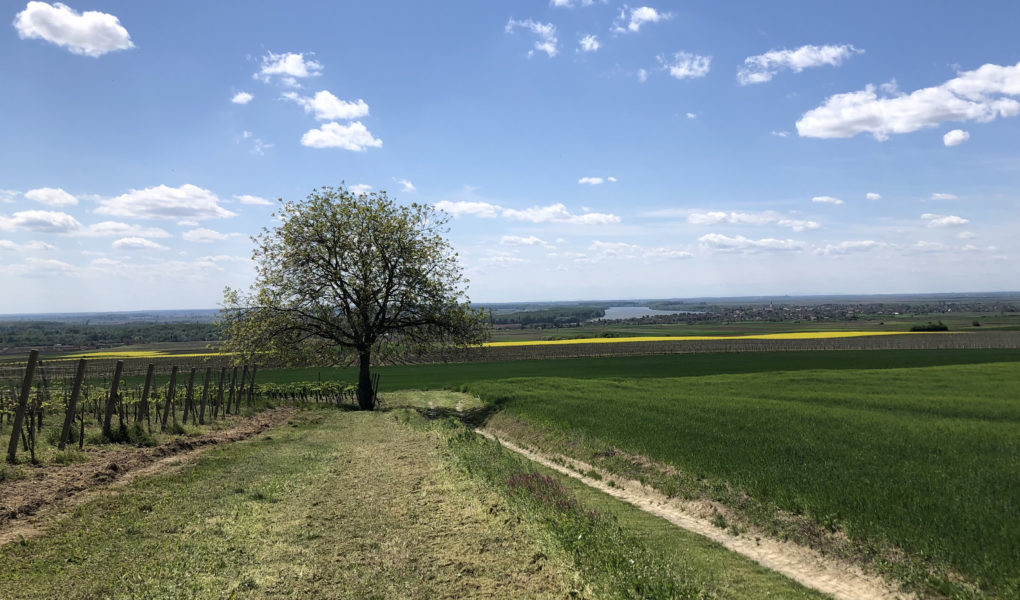This is the fifth in a series of 12 monthly articles following eight Croatian wineries through their year. Catch up on last month’s activities here.
Who’s the boss? This is an easy question for almost any wine maker: Nature is the boss. But as everything green grows rapidly in the May warmth, there are ways to start controlling the quantity and quality of fruit on the vines at harvest, as well as soil health and moisture. By now, bud break has happened everywhere in Croatia, for every grape variety. New shoots on the vines are anywhere from 5 to 30 centimeters long, and many already have little clusters of buds that will soon flower and transform into clusters of grapes. It’s time to start to get a handle on nature’s abundance.
Antunović
Jasna Antunović Turk stands on the gentle hill of Erdut, next to her vineyard of Zeleni Silvanac. Stripes and blocks of different colors—the medium green of barley, lush dark green of wheat, vibrant yellow of rape, and chocolate brown of newly tilled fields—descend below, with the town of Dalj edged by the snaking Danube, and Serbia beyond. Turk points out the dark green field of wheat beyond her walnut tree, where she will soon plant vines. She has slowly acquired and cleared many small plots on this hill to develop new vineyard land.
The Zeleni Silvanac has 5-centimeter shoots sprouting from the vine trunks and along the single cane left during pruning. This month, the winery team will choose the shoots on the cane that will bear grapes and use their fingers to pull off the others. “We choose the better ones, in cases where there are two [shoots] coming out or there is some kind of mess. [The new growth] has to have enough air to be healthy. And in the end to have 1.5 to 2 kilos of fruit per plant,” Turk says. This yield per vine is quite low, and helps ensure that the vine’s energy and nutrients are focused on fewer, better bunches of grapes.
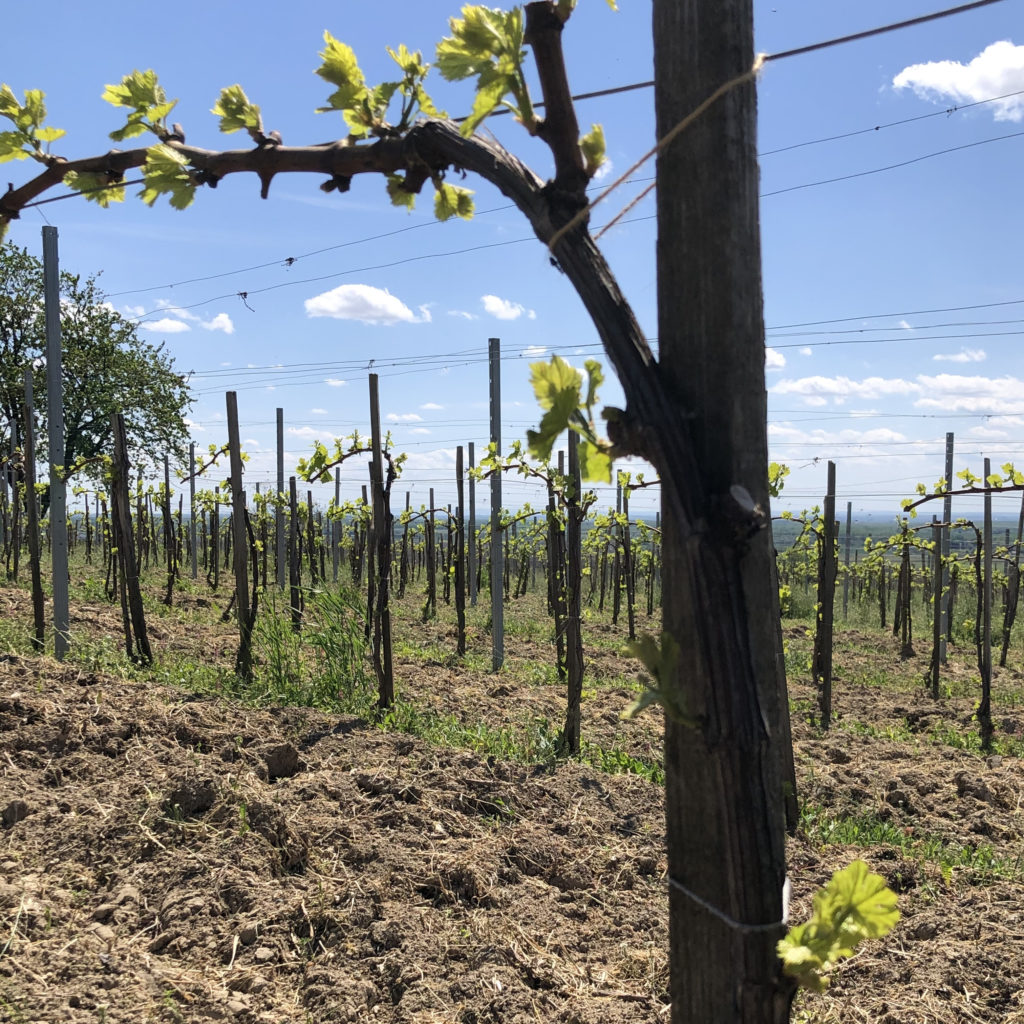
As we drive back to the winery in Dalj, we pass through vineyards whose vines look like unruly octopuses, with many unpruned canes trapped between the guide wires. Turk explains that these are set up to yield as much fruit as possible for a different local producer’s mass-market wine, and will survive only ten years or so before they are exhausted.
In the winery, most tasks leading up to bottling are intended to make the wine look the way consumers expect when they buy it: clear, with no “stuff” in it. This is especially true for white wines, which are Turk’s specialty. Protein stabilization is one of these tasks. All wines have microscopic bits of grape protein suspended in them after winemaking processes are complete. The proteins are unstable and will bind together if the wine gets too warm at some point in its journey from winery to table. This makes the wine look hazy. To avoid the problem, Turk uses a purpose-made slurry of fine bentonite clay. When the slurry is stirred into the wine, the proteins stick to the bentonite molecules and sink to the bottom of the tank. After about a month, she can move the clear wine off to a different tank.
Turk is about to bottle her Graševina from 2020, which was a great vintage in the Danube region. For the first time she will bottle it unfiltered. Unfiltered wines retain more texture and character than heavily filtered wines, although there is a middle ground that many winemakers hew to. Much of the decision comes down to the wine maker’s philosophy.
“I wanted somehow to divide the 2020 from all other vintages. So I will not filter it, because it is such a precious wine in a very unpleasant year,” Turk says, referring to the Covid pandemic. “That is my . . . appreciation to the vintage. It’s more sincere, you know?”
Korak
In Plešivica, the Korak vineyards are about one month behind their normal progress in early May. The severe frost in April delayed growth, and Josip Korak still can’t see for sure how much damage it did. He thinks it’s a 40% loss. Normally, frost wouldn’t affect the Korak vineyards so severely because they are situated higher up on the hilltops. This frost was so cold that not even the higher elevations escaped unharmed.
“[With this frost], everything stopped for two weeks. After two weeks everything started to grow again,” Korak says. He needs to see the flower bunches forming on the shoots before he knows which ones will produce fruit. The new shoots are only about 5 centimeters long and “it’s not every [bud], it’s every second you can see is growing. We will see how many grapes we will get. Maybe not every [shoot] will have grapes,” he says.
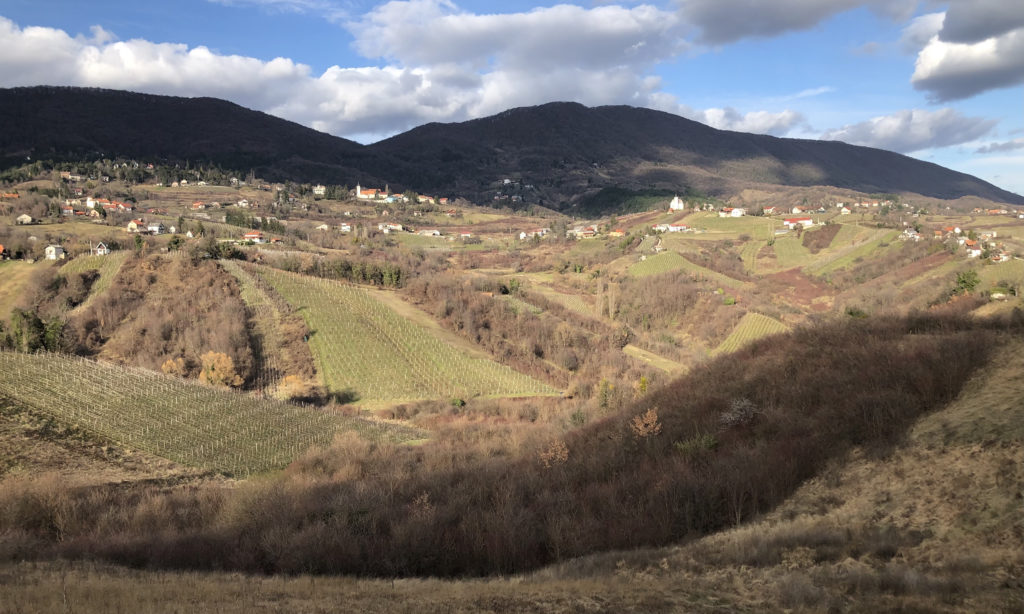
When they start thinning the shoots at the end of May, they’ll try to compensate a bit for the frost damage. “We will see what we leave. Maybe this year we will leave a little bit more because we don’t have enough.”
Meanwhile, the grass is growing fast because of the recent rains. While the Korak team wait for the vines to grow, they are cutting the grass between the rows. The grass will remain between the rows in the mature vineyards. In some of the younger vineyards they will turn the earth instead, to provide a little less competition for nutrients between the grass and the young vines.
In the winery, Korak is about to release a new wine for the first time, a vineyard blend of multiple grape varieties, which is part of their line of skin-macerated (orange) wines. “It’s from the oldest vineyard, 100 years old,” says Korak, “with two months maceration.” It will reach shops and restaurant lists at the end of May.
Krajančić
Dalmatia, with its balmy weather, is generally the farthest ahead in spring vine growth. And the grass is not far behind. From now on, cutting the grass between the rows and beneath the vines will be a weekly task.
“We are cutting grass because we decided not to use herbicides,” Krajančić says. “In March and April we did it by hand. Now the grass is stronger, so we have to use the tractors.”
“Here, people normally use herbicides, and because of using herbicides for years and years, now the grass has evolved. We have grass that is not typical for this region. When my grandma is talking about the grass, and how they used to cut it not to use herbicides, she always says the grass is completely different than it was 20, 30, 40 years ago. The grass now is growing very fast and very strong, and it’s hard to get rid of it.”
But the grass does offer some benefits in a dry region. “When we cut the grass we [leave it] on the surface, and when the rain falls the soil contains water for longer. Over time the grass will become humus. Now it only makes a difference because it prevents evaporation.”
Practically speaking, cutting the grass allows the family to see the vines clearly during shoot thinning. The shoots are 15 centimeters and longer, and are tucked between their guide wires to protect them from the wind and guide their growth upward. Now the family will pluck off the nonproductive shoots on the vine trunks, and leave only the best two or three buds on the cane to produce grapes.
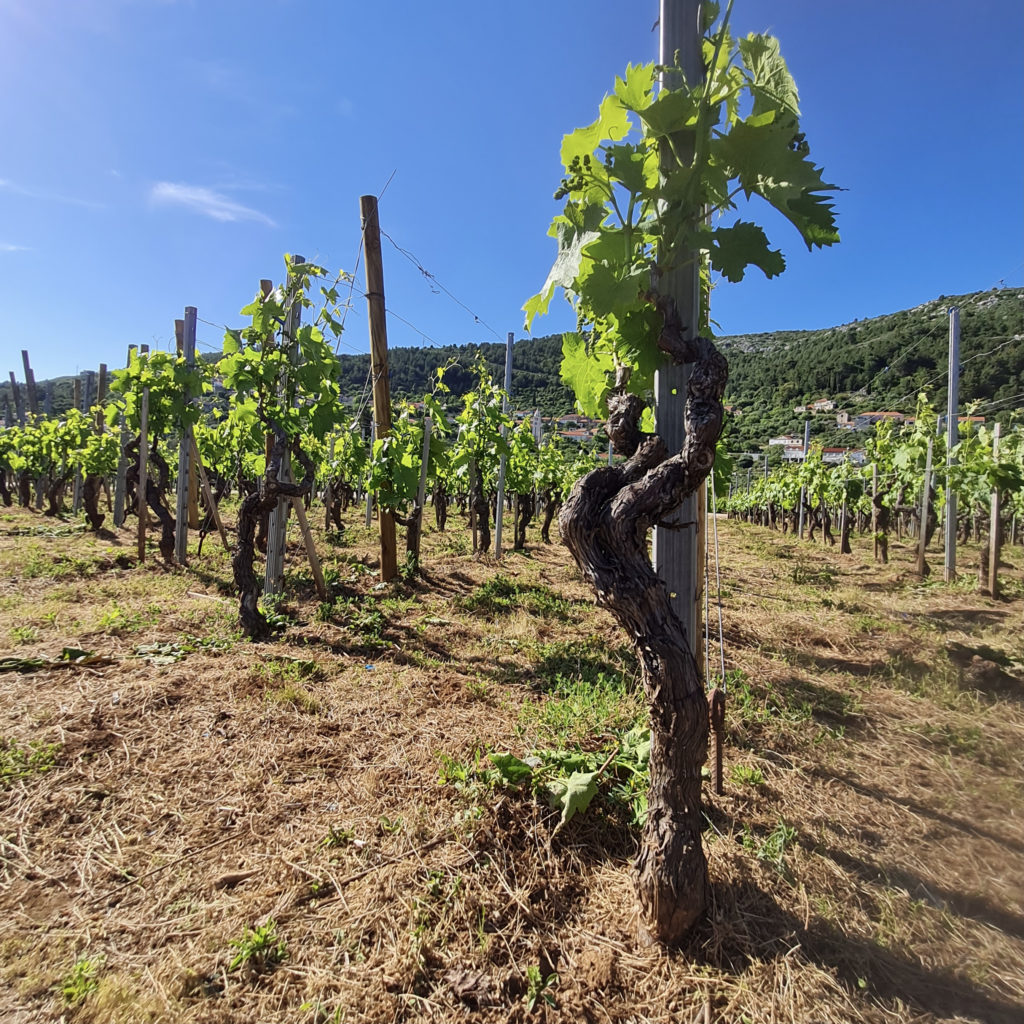
Krajančić explains, “Even in the beginning we are trying to reduce the amount of grapes that would grow if you let all the buds be. We can’t know, but we choose two or three buds that we think will be enough for the harvest. If we had four [or more] buds it would be a disaster because Pošip can bring all the grapes but the grapes won’t be as good.”
In a week or two will be the first vineyard treatment, against mildew. Pošip is susceptible to various mildews and rot when there is too much moisture around the grape bunches. The weather can help combat this problem. Right now there is a good balance of sun and rain. The dry season starts at the end of June and beginning of July. It is then that the timing of rainfall will have a big impact on the health of the grapes.
Krajančić says, “My father and grandma always say it’s the perfect time to rain in the first half of July. Because normally harvest is at the end of August and the beginning of September, it brings the grapes the necessary water and it doesn’t bring any diseases. If the rain falls [later] it can be disastrous because too much water [swells] the grapes to be bigger and bigger, they break, and it’s perfect for botrytis [rot].”
Clai
In Istria the frost in April only briefly put the vines on pause. “We didn’t have so much damage, and after that it started very quickly,” says Dimitri Brečević.
At Clai, rather than cutting the grass between the rows, they cultivate the earth with a harrow behind a tractor. This breaks the soil a bit, hinders the grass a bit, but doesn’t disturb the soil too much.
“In Istria the tradition was always to work the ground and not cut the grass,” Brečević explains. “Each area has its own techniques which are adapted to the ground, the [grape] variety, the climate. Here in Istria, if you leave the grass, at a certain point in June it starts to be very hot. The sun actually burns the grass, and our ground is white clay. The clay has a lot of capacity to hold water and it changes structure a lot. When the clay [dries out] you have big cracks on the ground, that you can put your hand inside. The heat is going into the ground, drying it, and that is the worst thing you can do for the [vine], but also for the microorganisms in the soil.”
The most important work this month will be shoot thinning and spraying. Even organic growers spray, says Brečević, “and because we work organically we have to [be proactive]. In organic, it’s not that you can repair or fix a situation, you have to keep the situation at a good balance. It’s really preventive.”
At Clai, though, they go one step further than organic—they follow the principles of biodynamic viticulture. Biodynamics takes a holistic approach to agriculture that treats the farm as a living organism. The soil, plants, animals and even the cycle of the moon are integral to the health of the organism. This month, the team at Clai will spray a preparation called 500 on the soil. Two weeks ago, they dug 30 cow horns out of the ground, which they buried a year ago. “What you have in the horn is cow shit—as simple as that,” Brečević explains. “You put it in the ground and it will be completely transformed into humus, compost, and it will be a very rich with microorganisms.”
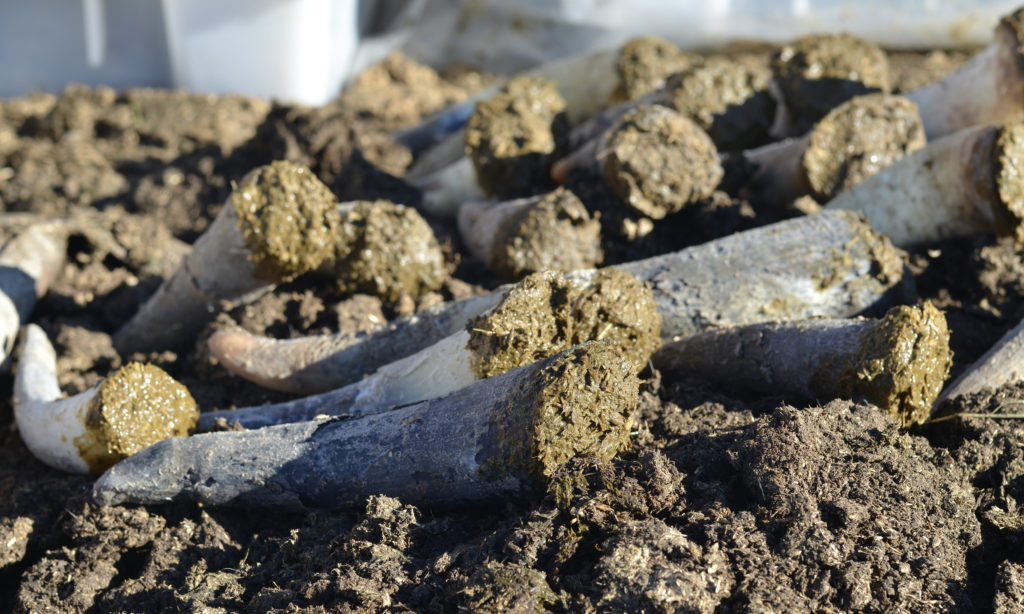
The manure is put in water and stirred to “dynamize” it. “This is a way to wake up, somehow, all these microorganisms, to give them all the energy and the possibility they can have,” says Brečević. The amount applied is tiny—50 to 100 grams per hectare, in 40 to 80 liters of water. “Biodynamie is not talking about quantities, it’s more about the quality of the preparation, more about respect of the [right] time to spray it,” says Brečević. “It’s more about how to help nature to do its own thing than to control nature.”
[Title photo: Antunović vineyards in Erdut, with Dalj and the Danube in the distance. Staff/CCM.]

